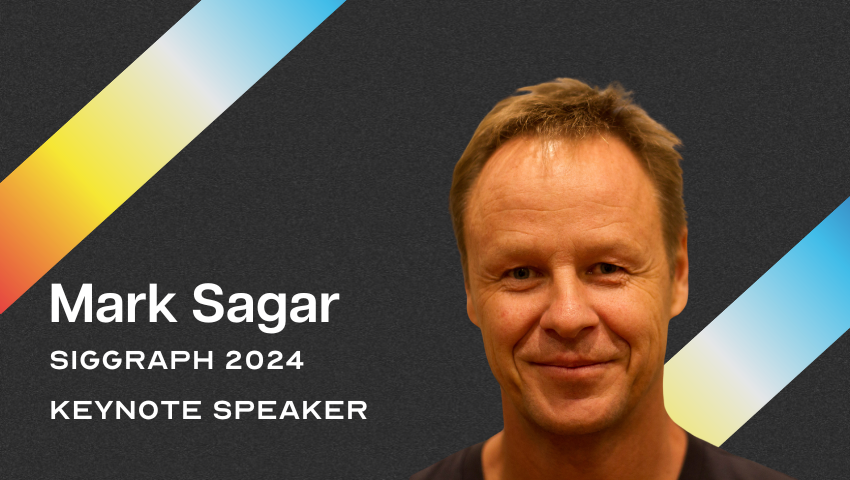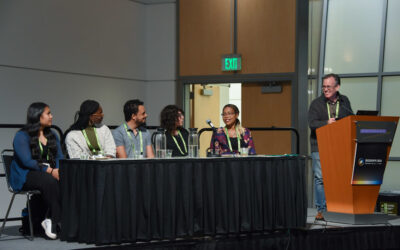Headshot courtesy of Mark Sagar
SIGGRAPH 2024 is thrilled to welcome double-Academy Award winner, co-founder and Chief Scientific Officer of Soul Machines, and Director of the Laboratory for Animate Technologies at the Auckland Bioengineering Institute Dr. Mark Sagar to the keynote stage this July. In his session “Beyond the Illusion of Life,” Sagar will take SIGGRAPH 2024 participants on a biologically based journey of giving an artificial character its own inner life. Before you hear this fascinating approach from Sagar at SIGGRAPH 2024, learn more about Sagar and interactive, digital, artificial characters here.
SIGGRAPH: SIGGRAPH 2024 is thrilled to welcome you as a Keynote Speaker. What first interested you in the concept of interactive digital characters?
Mark Sagar (MS): There are many influences, and it goes back a long way, from Douglas Hofstadter to Douglas Adams!
A pivotal time for me was when I was working on the faces for very high-quality characters in feature films where what mattered was conveying a sense of soul. But these were for a fixed story, only to be observed.
I thought, “Wouldn’t it be wonderful if we could bring these characters to life — so we could experience their presence — and agency? Imagine being put in the same space as King Kong — what would you do? Even every glance you make could be consequential!” Interactive characters with emergent behavior have unlimited possibilities — you can co-create infinite stories. But how could this be done? To do it with depth and so the character had autonomy, it would require building a digital brain and nervous system! With the advances in real-time computer graphics, neural networks, and new insights from neuroscience, it seemed like the time was right to build at least a large functioning sketch.
SIGGRAPH: How can digital, artificial characters foster greater human interaction?
MS: Ultimately, it is about making the most effective and intuitive feedback system.
For us, of all the experiences we have in life, face-to-face interaction fills many of our most meaningful moments. The complex interplay of facial expressions, eye gaze, head movements, and vocalizations in quickly evolving “social interaction loops” has enormous influence on how a situation will unfold. From birth, these interactions are a fundamental element of learning and lay the foundation for successful social and emotional functioning through life.
When it comes to the artificial, Donald A. Norman titled a book “Turn Signals Are the Facial Expressions of Automobiles” because they convey the intent of the driver in an intuitive, anthropomorphic way.
I think how much we should anthropomorphize machines is still an open question. What is most effective for enhancing communication when working with people?
SIGGRAPH: You and your team are pioneering the creation of autonomously animated virtual humans. What should SIGGRAPH 2024 participants know about this realm of technology before attending your keynote?
MS: It is really hard — we humans are complex! It is at once a holistic and highly interdisciplinary pursuit, from theoretical models to technology, and from science to art, reason to emotion. It also has a long history in computer graphics, e.g., Fred Parke’s talking face was done 50 years ago (SIGGRAPH 1974)! The work done by the MIT Media Lab and USC ICT, Justine Cassell, Dimitri Terzopolous, and others over the years has been really inspiring.
SIGGRAPH: SIGGRAPH 2024 is at the precipice of the next half century of computer graphics and interactive techniques distinction. How do you push the boundaries of what is possible to build a desired, technological future?
MS: Overall, I think a holistic human-centric approach is good, as well as being mindful to avoid creating unhealthy dependencies (e.g., our current addiction to devices).
In dynamic, ambiguous or complex cases where beneficial interaction with technology requires continuing feedback, wouldn’t it be wonderful to achieve a true rapport — a sense of flow — like the interplay of jazz musicians or a sports team? The more intuitive we can make it the better, so that it feels as natural as interacting with other people.
Can we fluidly bounce ideas off a machine in which creative sparks fly on both sides? Our human signals and goals need to be interpreted by technology and vice versa.
Creative play with intelligent machines will be a great and fun discovery tool, and it will keep us in the loop.
SIGGRAPH: What is one key takeaway you hope SIGGRAPH 2024 participants uncover from your keynote, “Beyond the Illusion of Life”?
MS: Human simulation requires a holistic approach which may be vital to unlocking the most beneficial potential of interacting with AI. I believe embodiment and a model of mind is required to make an agent relatable and able to operate best with humans in complex or ambiguous situations involving highly dynamic multimodal feedback loops, which we, naturally, deal with every day.
Human cooperation is the most powerful force in history. The way we interact and cooperate with AI will shape the next era.
Learn more about Dr. Sagar’s SIGGRAPH 2024 Keynote Presentation on our website, and subscribe to SIGGRAPH Conferences emails to be the first to know when registration is available this March.

Double-Academy Award winner Dr. Mark Sagar is the co-founder and Chief Scientific Officer of Soul Machines and Director of the Laboratory for Animate Technologies at the Auckland Bioengineering Institute. Mark and his team are bringing technology to life, pioneering the creation of autonomously animated virtual humans with virtual brains and nervous systems — capable of highly expressive face-to-face interaction and real-time learning and emotional response — to create the next generation of human interaction with biologically inspired artificial intelligence. Mark has a Ph.D. in engineering from the University of Auckland and was a postdoctoral fellow at MIT. He previously worked as the special projects supervisor at Weta Digital and Sony Pictures Imageworks and developed technology for the digital characters in blockbusters such “Avatar,” “King Kong,” and “Spiderman 2.” His pioneering work in computer-generated faces was recognized with two consecutive Scientific and Engineering Oscars in 2010 and 2011. Mark was elected as a fellow of the Royal Society of New Zealand in 2019 and was named New Zealand Innovator of the Year in 2022.



